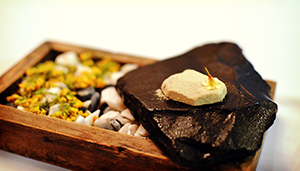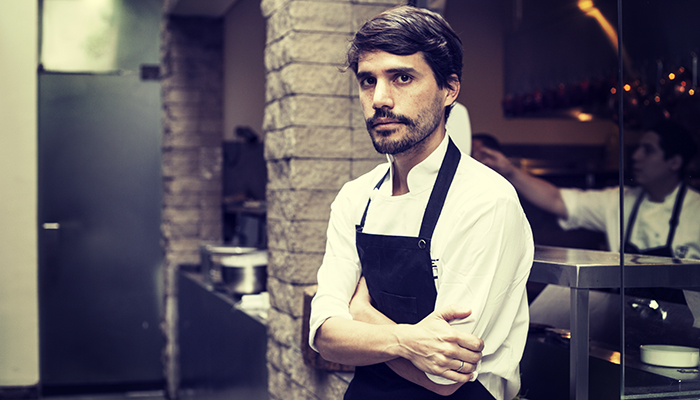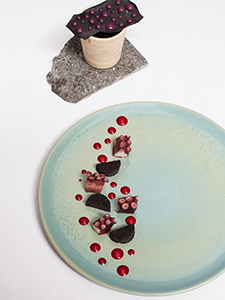
Dining at chef Virgilio Martínez’ flagship restaurant, Central, in Lima, Peru, is not only a fantastic culinary experience, but an educational one. Ingredients you’ve never seen or heard of appear time and again over the course of Martínez’ signature 17-course tasting menu, and he goes through great pains to ensure that it stays that way.
From ultra-purified water and a clay dust coating on a piece of chocolate, to the pisco used in a spherical dessert, Martínez, 37, is not only concerned with creating fabulous food, but knowing the very essence of its source. Each dish also represents its own ecosystem in Peru. Martínez can even trace the ingredients in a particular dish to a specific elevation in the country. On top of that, every menu item arrives at the table on its own custom dishware, created by his team’s own potter.
It’s this forward-thinking approach to food — and to the indigenous resources that selections originate — that has helped catapult Martínez to the top of the playing field. Central is universally considered one of the best restaurants in all of Latin America. Meanwhile, his newer eateries, Lima and Lima Floral, have also become stars on London’s restaurant scene.
Forbes Travel Guide caught up with Martínez on a recent visit to Lima to talk about his approach to food, to get a pulse on global dining trends, and to get his take on the best places to eat in Peru right now.
How would you describe your food?
I would describe it as very diverse. When I say “diverse,” I mean that I play with a lot of things that you probably haven’t tried before. It’s the unknown things. I prefer to keep my food Peruvian style. One hundred percent of our products are Peruvian. Having the possibility of cacao, coffee, olive oil and salts, all from Peru, we are able to do a “kilometer zero” cuisine — super local. If you go to a cosmopolitan city, they don’t grow coffee. When I go to London, you cannot get cacao in London. You get cacao here. You get coffee from here. Our commitment is to get the best of our things. I’m trying to push my producers to do the best from our products. Our local is about diversity. We cannot call our food seasonal, because you can get things from everywhere in Peru. There’s no seasonal asparagus in Peru, you know why? Because there’s a season [for them] on one side of Peru, but if you cannot get it from one side, you get it from the other side. If you cannot get it from the other side, you get it from the Andes.
How often are you changing the menu?
We’re changing it every two or three months. It depends on how many trips we’ve done [to find new local products]. When we see our country, we don’t see our country as seasons. We don’t see our country as a flat world; we see it as a vertical thing. That is the way our systems used to see Peru — going up, going down, going underground. That is the concept of Mater Elevations, the basis of our menu.
Tell us about your sourcing trips.
When we do these Mater trips [with the Mater Iniciativa group], we go in the morning. We take a one-hour flight to Cusco, and we come back in the afternoon. We go in a team, which includes myself, sometimes my wife, my sister (the director of Mater Iniciativa) and, usually, some cooks. We find products. We get to know people. In order to achieve the whole concept of the tasting menu, we need to get to know the producers and people. What is amazing is to get to know the people from the Amazonia that have never been seen before. First, we need a contact who speaks Spanish like us to give us the approach, because it is not easy. That is why our group has an anthropologist and a biologist. We also have a designer that designs all the dishes that our food is served on and our own potter who makes them.
How long have you been a chef?
I’ve been a chef a long time, 16 years. I was in New York, at Lutèce, then I moved to London, Spain, Bogotá, and then I finished here.
Each dish is its own ecosystem, is that correct?
Yes. For instance, we have this dish called the red Amazon, which is made of an Amazonian fish called paiche, with fruits called airampo (a prickly purple pear) and huito (an orange-sized fruit). One is red, the other is black. Amazonian communities dye their hair and paint their bodies with these fruits. The dish is an inspiration from getting in touch with this community, where they eat paiche, and they use these fruits to dye their hair. That’s how we work. We see people. We talk to people. We get the produce. It’s hard, because we have to go to the place, we have to go to the source. It’s not easy. It would be easier to go to the market, but then, we couldn’t be sure of where our products were coming from. There wouldn’t be any inspiration.
What are some of the strongest trends you’re seeing in South American cuisine today?
Casual, real food. I mean whole ingredients, less preparation and [being] more attached to tradition. We are in the time we celebrate our traditions and we want to show them as they are. The thing is we are seeing Latin America as a whole, not separately, so we are trying to see what we have in common, and we are exchanging this knowledge.
Outside of Peru, what are the best countries to visit for food right now?
I see amazing things in many countries. I really love diversity in food, ingredients and taste. I love hawker centers in Singapore and traditional Italian food in Tuscany. In terms of chefs, San Sebastián is the place I enjoy food. There, I visit Andoni Luis Aduriz of Mugaritz. In Bilbao, Eneko Atxa at Azurmendi and Josean Alija at Nerua. But really, I admire cooks from all over the world. Right now, I am in a state where I am in love with Latino-American concepts: Mexico’s Quintonil (chef Jorge Vallejo) and sud77 (Edgar Nùñez Magaña), Pujol (Enrique Olvera). In Brazil, of course, Alex Atala’s approach to food [is fantastic]. In Peru, Mitsuharu Tsumura at Maido, Gastón Acurio’s restaurants, [Monica Kisic’s] IK, Renzo Garibaldi at Osso [are great]. The list can continue.
What are the must-visit restaurants for anyone visiting Lima?
Osso for the best meat in Peru. Astrid & Gastón is a nice trip, amazing execution. IK — the beauty of the place and the sense of calm of the chef [Kisic] with her food is amazing. Maido is the best Nikkei (Japanese and Peruvian fusion) I have ever tried. I go there a lot when I am off. La Mar [Cebichería] and El Mercado are the places to go when you feel like you want ceviche.



